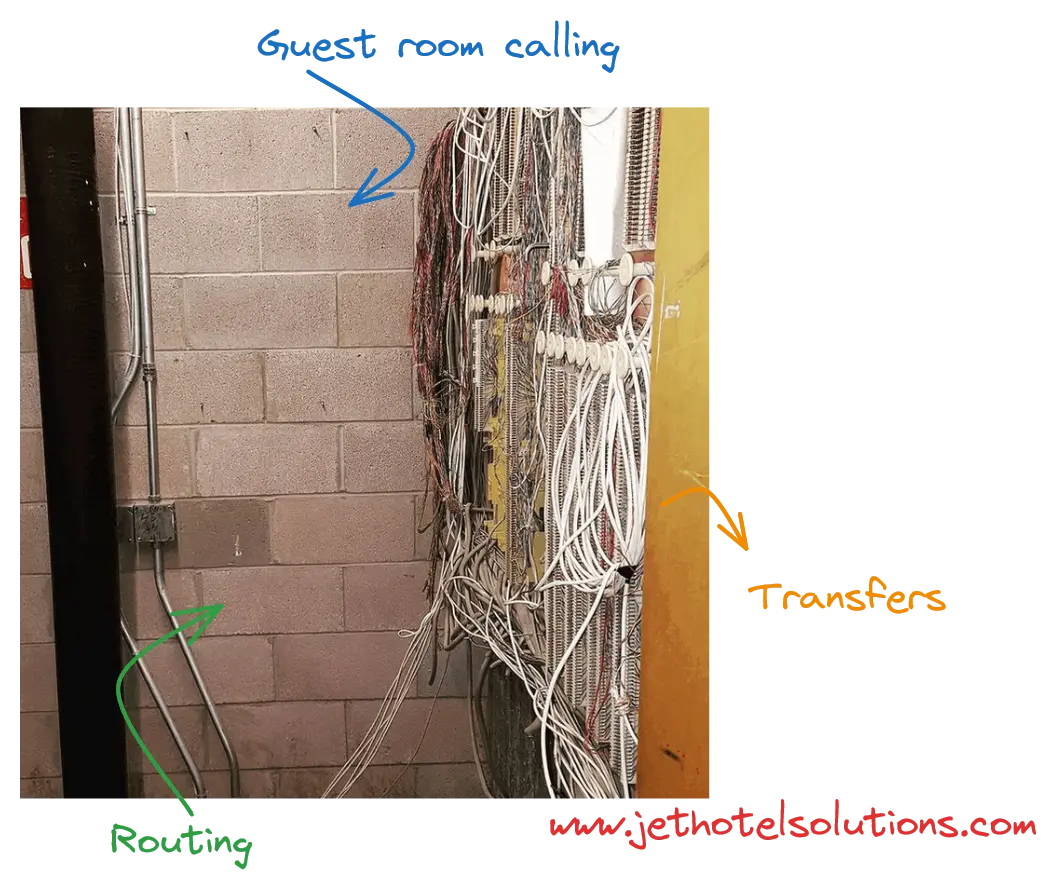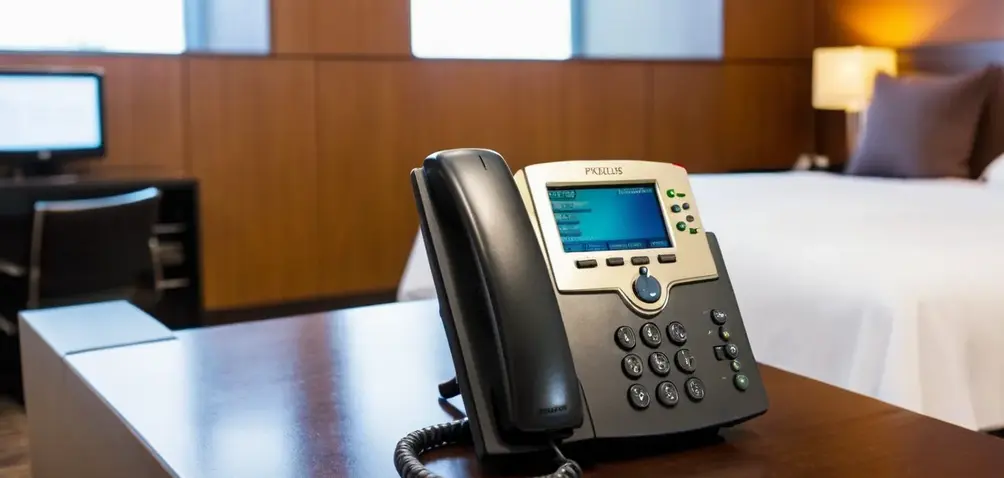Tucked away in the inner sanctums of hotels resides a little-known nerve center affectionately called the “PBX room”. This specialized space houses the telephony brains coordinating all guest and internal communications.
Given minimal visibility among patrons yet playing an outsized role enabling exceptional stays, an aura of mystique surrounds these crucial PBX hubs.
Let’s peel back the veil on what exactly PBX rooms are, their evolution, functionality, best practices, and ultimately why properly supporting this backbone matters more than ever for hotels aspiring towards service excellence.
PBX 101 – What It Is and Why Hotels Need It
For the uninitiated, PBX stands for private branch exchange. In plain terms, it’s a private localized telephone network consisting of specialized switching equipment allowing connections between internal extensions and external public lines.
 PBX systems empower key hotel capabilities like:
PBX systems empower key hotel capabilities like:
● Guest room calling: Enabling visitors to make external calls plus contact hotel departments and extensions
● Transfers: Seamlessly branching ongoing calls to appropriate teams like housekeeping or the spa
● Routing: Intelligently sending incoming reservations/inquiries to correct groups
● Intercom: Connecting hotel employees rapidly across departments
● Overhead paging: Central broadcasting messages to multiple zones
● Backoffice connectivity: Tying disparate operational systems together
Without these vital functions, chaos would erupt from constant phone line congestion given the volume of simultaneous guest-driven and internal contacts hotels handle 24/7.
Thus PBX represents the lifeblood underpinning hotel communications—making aptly equipping these command centers an imperative beyond merely providing Wi-Fi bandwidth.
From Bulky Manual Switchboards to Slick VoIP Systems
Hotel PBX capabilities have modernized drastically from early days. Instead of physically connecting calls via manual switchboards, intelligent call routing software now handles this digitally over internet protocol (IP) networks.
Grand luxury hotels in Chicago or New York historically flaunted dedicated operators managing intricate switchboards serving hundreds of guest lines. This setup spanned entire floors bustling with coordinators fielding requests around the clock.
Thankfully such labor-intensity got eliminated by progressing from analog to digital exchanges. Hoteliers migrated from wiring private branch circuits towards converged IP frameworks.

The exponential rise of cloud computing then provided the tipping point. Virtually the entire PBX hardware apparatus got replaced by remotely hosted telephony suites. This meant slashing costs, improving reliability via redundancy and expanding capabilities on-demand.
Bob Wilson, IT Director, recalls his trials during this transformation: “Our vintage system was limiting expansion despite strong occupancy growth. Technicians constantly battled archaic hardware. We had no disaster recovery. Cloud PBX solutions addressed all pain points allowing us to scale seamlessly while delivering five-star connectivity.”
Ultimately the combination of SIP-based VoIP, virtualization and cloud paved way from tedious manual switchboard rooms to highly resilient modern PBX hubs.
Inside Today’s Hotel PBX Rooms – What Really Happens There?
The inner workings of contemporary PBX spaces contrast old-school switchboard floors yet retain similar temperaments. Santosh Kumar, PBX Manager at Leela Palace New Delhi reveals typical proceedings:
● Troubleshooting: Handling guest complaints around call failures requires liaising with internet service providers and telephony vendors across faulty extensions, diagnosing root causes for our IT team. We trace complete episode details relaying them for rectification.
● Traffic Monitoring: Our dashboard reveals real-time PBX activity – incoming/outgoing calls, abandoned rates, conferencing uptick patterns, etc. I analyze this data identifying choke points and capacity needs across trunk lines, if upgrades required.
● Testing: We constantly evaluate new features like video conferencing, SMS integrations with PMS software updates. I coordinate rigorous testing ensuring no guest-impacting defects. Vendor demonstrations also occur observing call quality.
● Provisioning: Whether onboarding seasonal contractors or new hotel wings, rapidly programming and assigning PBX extensions is crucial for orientation and operational readiness. I oversee number creation and access policies aligned to staff roles.
● Vendor Management: Negotiating and liaising with communications partners around support, licensing, security and continuity falls upon my team. We authorize payments and track SLA compliances.
● Change Management: Before deploying PBX enhancements or modifications, meticulous planning is imperative given potential service disruption if changes fail. We handle careful release calendaring, documentation and backouts.
Kumar summarizes that despite relying on cloud-hosted environments, active governance prevents complacency. Protocols exist safeguarding upgrades, availability and security while also continually improving functionality.
Architecting Effective Hotel PBX Rooms
Given the pivotal functioning, optimizing PBX space layout and infrastructure bears significance. This allows unhindered operations, future-proofing and disaster resilience.
Industry blueprints recommend hotel PBX rooms feature:
■ Physical Security: Controlled access via strict permissions preventing unauthorized tampering. Biometric authentication and locks now feature alongside old-fashioned metal doors.
■ Power Protection: Uninterrupted electricity supply via 48-hour batteries and generators offer insurance given frequent grid instability in several regions. Built-in surge protection offers added safety.
■ Ventilation: Air conditioning and humidity control maintains optimal temperature and moisture conducive for sensitive telephony appliances.
■ Cabling Infrastructure: Structured cable raceways provide clean segregation between voice, data, Wi-Fi and CCTV networks minimizing interference. Generous access points provision sufficient ports aiding swift expansion or temporary connections during events like equipment swap-outs.
■ Redundancy: Backup PBX units remain compulsory for quick rollovers if primary systems get impaired. Failover protocols automatically reroute traffic securing continuity.
■ Connectivity: Multi-carrier SIP trunks prevent overdependency on single telecommunications providers. Dual fiber links using diverse paths eliminate potential fiber cuts impacting external connectivity.
Experts also suggest housing PBX infrastructure separate from general IT areas given unique power, performance and availability necessities.
Why Well-Supported PBX is Paramount
Maintaining PBX capabilities is growing even more imperative for hotels as guest engagement gets omnichannel. With travelers expecting messaging interactions alongside voice, having centralized visibility and control points becomes pivotal.
For instance, hotel apps now integrating conveniences like check-in, room controls, chatbots and service requests ride upon PBX foundations provisioning and securing connectivity capabilities.
Travel industry consultant Enrique Cruz, remarks: “Guests desire personalized, proactive and contextual interactions spanning channels, devices and dismiss prior brand affinity for better experiences. Hotels must harness guest data, mobility and AI through well-orchestrated communications hubs to retain loyalty beyond just transactions.”
With PBX sitting at the apex of this pervasive service paradigm, thoughtfully administered PBX rooms directly catalyze competitive differentiation or commoditization if inadequately invested in.
By holistically elevating support and continuously enriching functionality around the critical PBX nexus, hotels reinforce both guest stickiness and operational excellence for the long run.
Dispelling PBX Misconceptions
Despite significance, common PBX misconceptions still abound among certain hospitality professionals causing its value to get underappreciated:
Myth: PBX relevance diminishes given VoIP adoption across properties
Reality: Cloud capabilities still rely on robust local telephony infrastructure with PBX managing this reliability
Myth: Outsourcing PBX operations saves money
Reality: No outsider matches internal telephony domain expertise crucial for agility
Myth: PBX management is a thankless backoffice function
Reality: It’s a specialized skill elevating guest satisfaction even through mundane interactions
Myth: Old school PBX setups support hotels sufficiently
Reality: Modern tools contain costs while future-proofing experiences
Myth: Room for human oversight inside PBX rooms will evaporate
Reality: AI handles mundane tasks but complex triage still needs empathy
Hopefully this insight dispels prevailing PBX misconceptions and urges those glossing over it to re-evaluate gaps for resuscitating this invaluable hotel backbone.
With fundamental PBX proficiency now firmly grasped, hotels must reinvent PBX rooms as catalysts uplifting communication capabilities. Converting intent into infrastructure and astute support unlocks realizing hospitality’s noble purpose—making earnest human connections. When travelers feel properly heard, hotels hear success in return.
